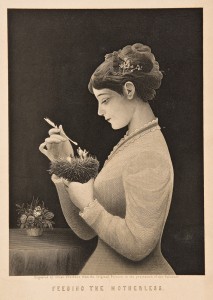The print called “Feeding the Motherless” from the Illman Brothers is striking because I think it directly relates to ideas about social responsibility that were strong throughout the Victorian Era and The Woman in White. The woman in this image is feeding baby birds, which are a completely helpless and frail entity. These are characteristics often applied to women in the Victorian Era, and the chicks physically resemble the image of women at this time. Both the woman and the birds are the same shade of white, indicating that they are related in some way. There is limited shading, but the artist has designed the image so that is seems as though light is emanating from the woman in the photo, while the darkness surrounds her. That light quality represents the supposed purity and moral superiority of noble women. These visual aspects of the print lead me to connect the baby birds to abandoned women and poor women, who cannot survive on their own. This relates directly to The Woman in White and its assortment of helpless females that must be helped to survive, even at the most basic level.
One such woman is Anne Catherick, who is “helped” first by Lady Glyde, who sees her as motherless and in need of moral and intellectual education. Glyde cleans her, dresses her all in white, and is attracted to her in large part because of her helplessness and inability to be like Laura herself. In a way, Anne promises to be an ongoing project that can never function independently, just as a bird trained to expect food from a human will never learn to hunt on its own. The fact that an upper class woman is feeding the birds as a leisure activity reveals an interesting aspect of Glyde’s care for Anne, as she sees it as something that fills her time and gives her satisfaction. She tells her husband the result of Anne’s consultation with the doctor, writing, “he says her careful bringing-up at school is a matter of great importance just now, because her unusual slowness in acquiring ideas implies an unusual tenacity in keeping them,” which is very revealing because it shows that the doctor essentially wants someone to control the ideas entering Anne’s mind (Collins 60). Lady Glyde proceeds to educate Anne, dressing her all in delicate lace frocks and beginning to instill ideas about traditional femininity in her mind. Like the abandoned birds, Lady Glyde feeds Anne things that are not natural for her, leaving her without the ability to live on her own. In this way, the doctor’s prophecy comes true when her mind becomes warped and cannot function properly.
Laura exemplifies the way that hand feeding a helpless woman through adulthood leaves her similarly without the ability to be independent. She is raised being fed ideas, and so when she is faced with opportunities to decide her own fate, she cannot act on her own behalf. She has been trained to serve men and to remain pure and honest, and so even though she does not love Percival, she cannot exit her engagement for fear of defying all that she believes a woman should be. She expects to be delivered the correct answer, much like a domesticated bird waits to be fed in the nest. Even though she ends up in a stable situation, her welfare has been the activity filling Walter and Marion’s lives, and will presumably continue that way. These two delicate birds in the novel end up unable to survive on their own, dependent on patrons to care for them.
Image: http://collections.troutgallery.org/Obj18174?sid=59379&x=611464

Hey, because I also talked about Feeding the Motherless I felt like I had to respond haha. I was really interested in the way that you deeply connected this image to WIW, because I did so in a completely different way. But now with this knowledge about the birds representing both my ideas of the birds as children, and your idea of the birds as helpless women, I’m curious about how we can tie these two together. Could it be that they could be both and represented as such? *gasp*. With Laura’s case, one could certainly make this argument, as she is consistently labeled as a child. However, I don’t know if I particularly agree with the part when you discuss Glyde caring for Laura in reference to this image, because I think it might be a bit of a stretch. But I do agree with the fact that this women in the image is obviously caring for something, radiating her inherent motherhood.
You make an interesting point when you say “That light quality represents the supposed purity and moral superiority of noble women” when discussing how it looks like light is emanating from the woman. The woman who is fulfilling her feminine “duty” by mothering the bird is cast in bright light. This contrasts with how we see Marian and Laura in The Woman in White. Laura is the one who is seen as light, fair, and bright, while Marian is seen as dark. Marian, the dark woman, is the one who fulfills all the feminine roles in the novel however. I like your idea of Anne being seen as a helpless bird, and I also think that we can see Laura take on this role after she escapes from the asylum. She needs to be constantly taken care of, taken on walks, comforted, and reassured.